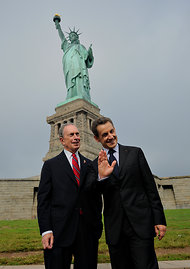Qu’est qui ce passe en France?
Ashley Baxstrom: What's up with France? President Nicolas Sarkozy of France joined President Barack Obama here in New York last week to celebrate the 125th anniversary of France’s gift of the Statue of Liberty to the US. The statue was originally dedicated on Oct. 28, 1886 in recognition of the French-American friendship established during the Revolutionary War. Both leaders hailed the statue as a symbol of freedom. “It is not simply a statue,” Sarkozy said through a translator. “It is a notion, an idea, an emblem. It is for all people of the world.” But while the French were proud to offer America “The Statue of Liberty Enlightening the World” (full titles, please), they seem to be having more trouble balancing the values of la liberté and l'éclaircissement in their own country.
Ashley Baxstrom: What’s up with France? President Nicolas Sarkozy of France joined President Barack Obama here in New York last week to celebrate the 125th anniversary of France’s gift of the Statue of Liberty to the US. The statue was originally dedicated on Oct. 28, 1886 in recognition of the French-American friendship established during the Revolutionary War.
Both leaders hailed the statue as a symbol of freedom. “It is not simply a statue,” Sarkozy said through a translator. “It is a notion, an idea, an emblem. It is for all people of the world.” But while the French were proud to offer America “The Statue of Liberty Enlightening the World” (full titles, please), they seem to be having more trouble balancing the values of la liberté and l’éclaircissement in their own country.
***
France understands itself to be a secular state, and since the French Revolution in 1789 has aggressively pursued secularism in the public sphere, from marching on Rome – twice – to a 1905 law mandating separation of church and state. Historically, that mandate has been worked out via the public school system, which was instructed in 1937 to keep religious signs out of the classroom; that decision was ruled illegal in 1989.
However, since the heavy influx of mass migration from North African states (particularly those that once were French colonies) since the 1960s and 70s, things have changed. In 1994, the French ministers banned the display of “ostentatious” religious signs in schools. Besides the obvious question of what constitutes “ostentatious” and who makes that call, there’s a deeper concern that begs to be addressed: What exactly does the French state consider “religion,” and who’s being most affected by these rulings?
Judging from recent legislative acts, the answer to both questions is the same: Islam. Muslims seem to be receiving the blunt end of France’s secularism stick these days.
First there was the ban on religious symbols in schools, approved by Parliamentary vote in 2004, which includes skullcaps, crosses and headscarves. Then in July 2010, parliament voted to ban wearing the full Islamic veil in public (click here for an illustrated BBC graphic about different veils!), with 335 votes for and 1 against in an Assembly of 557 seats. Justice Minister Michele Alliot-Marie said it was a victory for democracy and for French values, declaring “Democracy thrives when it is open-faced,” and citing the need to “liberate” oppressed women. Critics said most women wearing the veils – an estimated 2,000 – don’t fit the stereotype of marginalized, abused women and that the ban was itself stigmatizing and unconstitutional.
Most recently, on Sept. 16, a state-wide French ban on prayer in the street went into effect. Once again, the ban seems to be primarily concerned with removing Islam from public spaces. As a country, France has been not only spiritually but physically unaccommodating to its 5-million-strong Muslim population: there simply aren’t enough mosques. In July 2010, Dalil Boubakeur – rector of the Grande Mosque of Paris and former president of the French Council for Muslims – called for the number of mosques to be doubled to 4,000. At present, many Muslims find themselves praying on the street (especially during regular Friday prayers) because they can’t fit into the available mosques. When the latest ban went into force, the “overflow” was herded into makeshift prayer spaces, including former industrial sites. Some were thankful for a roof over their heads; others were offended by the improper prayer space.
***
France’s resolve to be a so-called secular state is its own to make, and living in a country with its own church-and-state border issues we Americans might not have any specific or useful suggestions. However, it is incumbent on the French people and government to be clear about how they define religion, what constitutes public, and to make sure they are fair and equal in enforcement.
If France wants to hold onto its national motto – “Liberté, égalité, fraternité” – it needs to ask itself, which stands taller: Lady Liberty or the French secularism? Or perhaps more precisely: which stands taller, and for whom?

